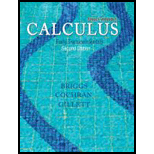
Rearranging series It can be proved that if a series converges absolutely, then its terms may be summed in any order without changing the value of the series. However, if a series converges conditionally, then the value of the series depends on the order of summation. For example, the (conditionally convergent) alternating harmonic series has the value
Show that by rearranging the terms (so the sign pattern is + + −),
Want to see the full answer?
Check out a sample textbook solution
Chapter 8 Solutions
Single Variable Calculus: Early Transcendentals (2nd Edition) - Standalone book
Additional Math Textbook Solutions
University Calculus: Early Transcendentals (4th Edition)
College Algebra with Modeling & Visualization (5th Edition)
A First Course in Probability (10th Edition)
College Algebra (7th Edition)
Calculus for Business, Economics, Life Sciences, and Social Sciences (14th Edition)
A Problem Solving Approach To Mathematics For Elementary School Teachers (13th Edition)
- 4. Please solve this for me and show every single step. I am studying and got stuck on this practice question, and need help in solving it. Please be very specific and show every step. Thanks. I WANT A HUMAN TO SOLVE THIS PLEASE.arrow_forward3. Please solve this for me and show every single step. I am studying and got stuck on this practice question, and need help in solving it. Please be very specific and show every step. Thanks.arrow_forward5. Please solve this for me and show every single step. I am studying and got stuck on this practice question, and need help in solving it. Please be very specific and show every step. Thanks. I WANT A HUMAN TO SOLVE THIS PLEASE.arrow_forward
- 2. Please solve this for me and show every single step. I am studying and got stuck on this practice question, and need help in solving it. Please be very specific and show every step. Thanks.arrow_forward1. Please solve this for me and show every single step. I am studying and got stuck on this practice question, and need help in solving it. Please be very specific and show every step. Thanks.arrow_forwardQ1/Details of square footing are as follows: DL = 800 KN, LL = 500 kN, Fy=414 MPa, Fc = 20 MPa Footing, qa = 120 kPa, Column (400x400) mm. Determine the dimensions of footing and thickness? Q2/ For the footing system shown in Figure below, find the suitable size (BxL) for: 1. Non uniform pressure, 2. Uniform pressure, 3.Uniform pressure with moment in clockwise direction. (Use qmax=qall =200kPa). Property, line M=200KN.m 1m P-1000KNarrow_forward
- Q2/ Determine the size of square footing to carry net allowable load of 400 kN. FS-3. Use Terzaghi equation assuming general shear failure. 400KN 1 m += 35" C=0.0 Ya = 18.15 kN/m³ +=25" C=50 kN/m² Ya 20 kN/m³arrow_forward4 x+3 and g(x)=x2-9 4X-10 2X --13) The domain of rational expression A) 1R. {-2,-8} AB -14) Let f(x) = B) 1R. {2,-4,-8} 4X-12 x² +6x-16 X3+7X²+12X ? C) 1R \ {-4,-3,0} then f(x) + g(x) is equal ro D) IR 2 A) B) c) D) x²-9 x2-9 x²-9 x+4 DB 5x-4 A B If + then the value of B is equal to X+1 A) 4 B) 2 C) 5 D) 3 4X 4x+4 С.В.... x2+5X+6 x2 (x-2)(x+1) X-2 AC 16 The solution set of the equation A){4} B) {-3} C){ 1} 17 The solution set of the equation A) (-3,-2) B) [-3,0) C)[-3,-2] D). [-2,0) BA -18) Which one of the following is proper fraction? 2x+4 ≤0 入×1 x+2x+4 (x+1)(x+2) 2x+4x+2 = 4 X+1 is equal to D). {-5} ≤0 A) x6 +4 2x+12 2X x +4 B) c) x2-9 AL 2x+12 D) x+4 14) let g(x) = [x-3],then g(-2) is equal to A) -5 B)-6 C)-3 D) 3 Part III work out (show every step cleary) (2pt) 20. E9) Find the solution set of the equation 2x+4 x+1 ≤0 P(x) (a) P(x) =≤0 2x+4 50 x+1 x+1≤ 2x+4 (x-1)(x-2) x= 1 or x=2 solution is {1.2} x-1=0 of x-2=0 x = 1 or = 2arrow_forward8d6 عدد انباء Q/ Design a rectangular foo A ing of B-2.75m to support a column of dimensions (0.46 x 0.46) m, dead load =1300kN, live load = 1300kN, qa-210kPa, fc' 21 MPa, fy- 400 MPa. =arrow_forward
- Q1/ Two plate load tests were conducted in a C-0 soil as given belo Determine the required size of a footing to carry a load of 1250 kN for the same settlement of 30 mm. Size of plates (m) Load (KN) Settlement (mm) 0.3 x 0.3 40 30 0.6 x 0.6 100 30 Qx 0.6zarrow_forwardThe OU process studied in the previous problem is a common model for interest rates. Another common model is the CIR model, which solves the SDE: dX₁ = (a = X₁) dt + σ √X+dWt, - under the condition Xoxo. We cannot solve this SDE explicitly. = (a) Use the Brownian trajectory simulated in part (a) of Problem 1, and the Euler scheme to simulate a trajectory of the CIR process. On a graph, represent both the trajectory of the OU process and the trajectory of the CIR process for the same Brownian path. (b) Repeat the simulation of the CIR process above M times (M large), for a large value of T, and use the result to estimate the long-term expectation and variance of the CIR process. How do they compare to the ones of the OU process? Numerical application: T = 10, N = 500, a = 0.04, x0 = 0.05, σ = 0.01, M = 1000. 1 (c) If you use larger values than above for the parameters, such as the ones in Problem 1, you may encounter errors when implementing the Euler scheme for CIR. Explain why.arrow_forward#8 (a) Find the equation of the tangent line to y = √x+3 at x=6 (b) Find the differential dy at y = √x +3 and evaluate it for x=6 and dx = 0.3arrow_forward
- Algebra & Trigonometry with Analytic GeometryAlgebraISBN:9781133382119Author:SwokowskiPublisher:Cengage


